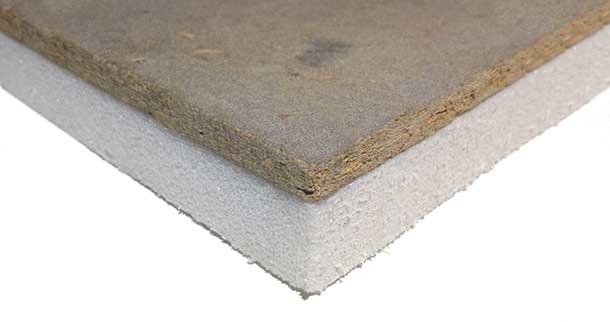BetonStrong
Coupled panels for dry screeds with cement bonded particle board and polyethylene terephthalate panels.
Panel for thermo-acoustic insulation, it combines the BetonWood panel with a polyethylene terephthalate panel.
![]()
![]()
![]()
![]()
![]()
Related articles
BetonStrong is an extremely versatile product as it is suitable for multiple applications in the building sector, since the advantages of two materials are combined in one coupled: on the one hand a material with high mass and high resistance to compression, the high cement bonded particle board BetonWood density, indispensable for obtaining adequate thermal displacement and great noise reduction, and on the other an expanded PET panel characterized by lightness, high insulating capacity, easy processing and high resistance to compression. Both materials are of excellent quality, processed with the most advanced technologies, subjected to strict process controls, CE marked.
The high-performance BetonStrong insulation panel is a laminate made up of two factory-bonded layers, one in cement bonded particle board and one in expanded polyethylene terephthalate (PET):
• The BetonWood cement bonded particle board is a very strenght material, it has an high density 1350 kg/m³ and high compressive strenght (9000,00 KPa); it is made of Portland cement conglomerate and peeled pine wood fiber, a recyclable, incombustible material, resistant to temperature and climatic changes, to insects and fungi and to atmospheric agents.
• Expanded polyethylene terephthalate is a structurally strong thermoplastic material perfectly suitable in a variety of applications to increase performance and reduce weight. The characteristics of the material make laying very easy and fast even with high temperatures. It has excellent chemical resistance and is compatible with all bonding systems with commonly used resins (eg polyester, epoxy resins, etc.). With its performance it can be easily used in prefabricated systems.
BetonStrong adapts to any use, in the field of thermal insulation and is particularly suitable for all cases in which there is a strong moisture component and the need for a material with considerable compressive strength.
In particular it is used as:
• insulation of elevated floors;
• correction of thermal bridges;
• external and internal thermal insulating composite systems;
• formworks;
• reverse roofs;
• insulated systems for windows, in particular for the insulation of roller shutter boxes;
• traditional and elevated dry screeds.
| Thickness of the PET panel(mm) | |||||||||||
|---|---|---|---|---|---|---|---|---|---|---|---|
| Betonwood thickness (mm) | 30 | 40 | 60 | 80 | 100 | 120 | |||||
| 8 | • | • | |||||||||
| 10 | • | • | |||||||||
| 12 | • | • | • | • | |||||||
| 14 | • | • | • | ||||||||
| 16 | • | • | • | ||||||||
| 18 | • | • | • | ||||||||
| 20 | • | • | • | • | • | • | |||||
| 24 | • | • | • | ||||||||
| 28 | • | • | • | ||||||||
| 40 | • | • | • | ||||||||
| Available thicknesses | ||
|---|---|---|
| Cement bonded particle boards with a thickness from 8 to 40 mm ON REQUEST UP TO 3000X1200 | 1200 x 500 | 1200 x 600 |
| Cement bonded particle boards with a thickness of 20 mm SANDED AND STEPPED | 1200 x 500 | |
•
standard thicknesses
• thicknesses on request
The table proposes standard thicknesses and formats according to the experience gained by our company in direct contact with the building world for years, to propose the best solutions in the field of thermal insulation. Larger formats are also available (3200x1250, 2800x1250, 2600x1250).
For the aforementioned sizes with a panel thickness exceeding 20 mm or for any other customization, minimum orders of 300 square meters are required.
The insulation can be combined with the Betonwood cement bonded particle boaards with even lining in order to improve the laying, in particular for the realization of dry screeds and radiant screeds.
cement bonded particle board BetonWood
| Density (kg/m³) | 1350 |
| Fire resistance according to EN 13501-1 | A2-fl-s1 |
| Thermal conductivity coefficient λD W/(m∗K) | 0,26 |
| Specific heat [J/(kg∗K)] | 1880 |
| Resistance to vapor diffusion μ | 22,6 |
| Coefficient of linear thermal expansion α | 0,00001 |
| Thick swelling after 24 hours in water | 1,5% |
| Surface PH value | 11 |
| Resistance to compression (kPa) | 9000,00 |
insulating expanded PET panel
| Density (kg/m³) | 115 |
| Fire resistance class | F1 |
| Thermal conductivity coefficient λD W/(m∗K) | 0,032 |
| Volume mass (kg/m³) | 125 |
| Compression resistance (kPa) | 1500 |
| Compression module (kPa) | 100.000 |
| Cut strength (kPa) | 900 |
| Cutting module (kPa) | 28.000 |
| Elongation to cut (%) | 12 |
| Density variation (%) | 115 |


